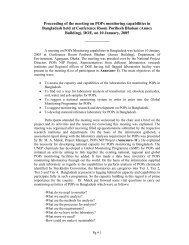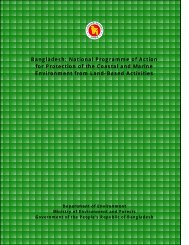Draft CMP HH - the Department of Environment
Draft CMP HH - the Department of Environment
Draft CMP HH - the Department of Environment
Create successful ePaper yourself
Turn your PDF publications into a flip-book with our unique Google optimized e-Paper software.
Coastal and Wetland Biodiversity Management Project BGD/99/G31<br />
Hakaluki Haor <strong>Draft</strong> Conservation Management Plan<br />
• Develop an M&E framework which uses biological indicators to assess <strong>the</strong> effectiveness <strong>of</strong> <strong>the</strong><br />
demonstration sites as a strategy for <strong>the</strong> conservation <strong>of</strong> biodiversity<br />
• Introduce mechanisms which allow local community groups to sustainably utilise <strong>the</strong> range<br />
benefits and services provided by well established demonstration sites<br />
• Define <strong>the</strong> parameters which contribute to <strong>the</strong> successful establishment <strong>of</strong> a demonstration site<br />
to support replication <strong>of</strong> additional sites throughout <strong>the</strong> ECA.<br />
Primary Outcome/ Output<br />
• Demonstration pilot sites identified, established and managed by and for local community<br />
groups<br />
• Demonstration pilot sites used to educate and raise awareness<br />
Constraints<br />
• May be difficult to agree on suitable sites<br />
• Obtaining permission from local land-owners and relevant government agencies may prove slow<br />
and cumbersome<br />
• Communities may not support <strong>the</strong> concept <strong>of</strong> demonstration sites over <strong>the</strong> long-term<br />
7.2.3 Wildlife Sanctuaries<br />
There are a number <strong>of</strong> sites throughout <strong>the</strong> ECA which are particularly significant for <strong>the</strong><br />
conservation <strong>of</strong> ecologically important or threatened plant and animal species/ communities. The<br />
need to establish sanctuaries to protect critically endangered species such as <strong>the</strong> Lesser Adjutant<br />
(Leptoptilos javanicus), Pallas Fish Eagle, Ganges River Dolphin (Platanisea gangetica), Common<br />
Otter (Lutra lutra), Phayre’s Langur (Trachypi<strong>the</strong>cus phayrei), Reticulated Python (Python<br />
reticulata), <strong>the</strong> Asiatic S<strong>of</strong>t-Shell Turtle (Chitra indica), Bacha (Eutropiichthys vacha), Bagha Air<br />
(Bagarius bagarius), Rita (Rita rita), and Gharua (Clupisoma garua) is particularly urgent (add<br />
o<strong>the</strong>r species as required here).<br />
A significant number <strong>of</strong> sites have already been identified as wildlife sanctuaries especially for <strong>the</strong><br />
protection <strong>of</strong> birds and fish. Initial work to prioritise <strong>the</strong>se sites has been undertaken but in many<br />
cases fur<strong>the</strong>r research and data collection is required.<br />
Management Actions<br />
• Raise awareness among local community groups about <strong>the</strong> ecological importance <strong>of</strong> establishing<br />
bird sanctuaries especially for globally significant and nationally threatened species<br />
• Raise awareness among local community groups about <strong>the</strong> ecological and socio-economic<br />
importance <strong>of</strong> wildlife sanctuaries especially in relation to threatened and vulnerable species <strong>of</strong><br />
fish as <strong>the</strong>se coming under increasing pressure from unsustainable and unregulated fishing<br />
practices<br />
• Continue to survey, identify and prioritise suitable sites as sanctuaries for <strong>the</strong> protection <strong>of</strong><br />
biodiversity in particular species and communities whose survival depends upon immediate<br />
deployment <strong>of</strong> conservation measures<br />
• Identify and articulate major rehabilitation and protection requirements and develop a plan for<br />
<strong>the</strong> effective management <strong>of</strong> each sanctuary identified<br />
• Work with local communities and relevant government agencies to establish sanctuaries<br />
especially for <strong>the</strong> most vulnerable species<br />
Prepared by UNOPS Consultant Mr. Sulma Warne August/ September 2005 for Project BGD/99/G31 21





